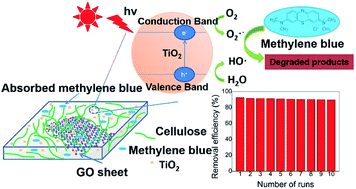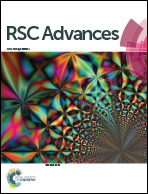Effective photocatalytic degradation and physical adsorption of methylene blue using cellulose/GO/TiO2 hydrogels†
Abstract
Environmentally friendly cellulose/GO/TiO2 hydrogel photocatalyst has been successfully fabricated via a green, simple, and one-step method and evaluated as the photocatalyst and adsorbent for the removal of methylene blue (MB). The XRD and FTIR analysis suggested the strong interaction among cellulose, GO and TiO2, resulting from the formation of hydrogen bonds. Due to the unique porous structure of cellulose hydrogel and introduction of GO, the cellulose/GO/TiO2 hydrogel showed superior (degradation ratio ∼ 93%) and reproducible (no significant change during the ten consecutive cycles) performance in the removal of MB under UV light. Consequently, the prepared cellulose/GO/TiO2 hydrogel can be applied as an eco-friendly, high-performance, reproducible, and stable photocatalyst and adsorbent for the removal of MB. This green hydrogel is a promising candidate for dye wastewater treatment. Moreover, this work is expected to extend the scope of bio-templated synthesis of other nanomaterials for various applications.



 Please wait while we load your content...
Please wait while we load your content...